Snohomish County, Wash. Underground Stormwater System Rehabilitation
Snohomish County, Wash. | Property Management | Stormwater Management
Overview:
A multi-family property received a notice of violation (NOV) listing fifteen deficiencies requiring corrective action. The initial concern was an illicit connection entering the stormwater drainage vault containing approximately 600,000 gallons of runoff.
Problem:
This vault flows downstream to a wetland and later a drinking well, which was Snohomish County’s greatest concern. Stormwater systems are the responsibility of property owners to maintain and repair when needed. This property owner called AQUALIS to find the illicit connection, then remediate the related vault, pipes and catch basins to ensure the system was properly restored.
An illicit connection of contaminated water entered the stormwater system at this property and derived from one of the four buildings on the property. Illicit discharge is defined as the disposal of a substance other than stormwater into the stormwater system. In this case, non-stormwater was connected to the stormwater drainage system which required disconnecting immediately.
The stormwater system at this property is an underground vault which stores all stormwater until it continues downstream. The vault had to be completely emptied in order to be properly cleaned. During this process, called dewatering, AQUALIS removed the contaminated stormwater from the vault in stages and relocated it to a treatment facility in a neighboring county.
In the extensive process of finding the illicit connection, another was discovered. A full dye test was performed to identify the location of the second connection. AQUALIS utilized analytics and underground camera inspections (CCTV) to monitor all stormwater lines on the property and identify the discharge. Once both illicit connections were properly redirected, the dewatering and cleanout could begin.
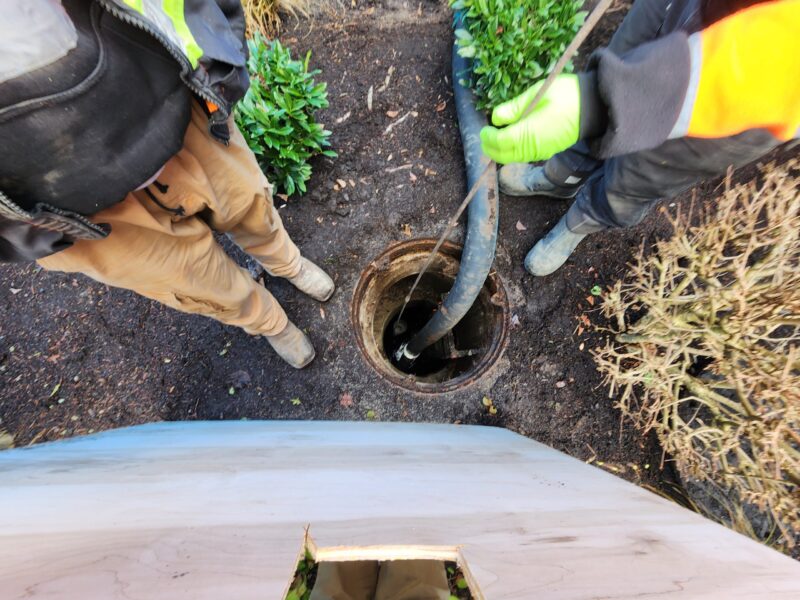


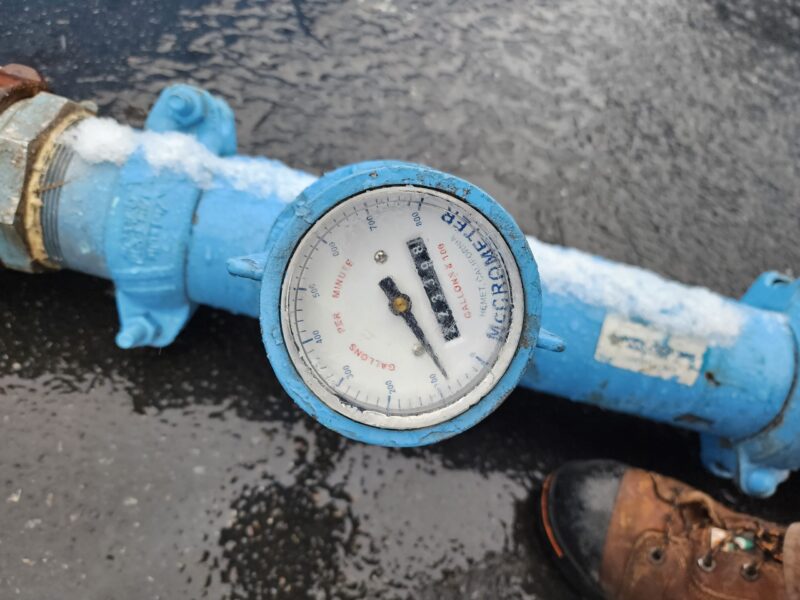
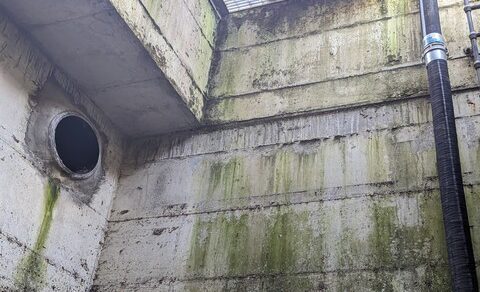

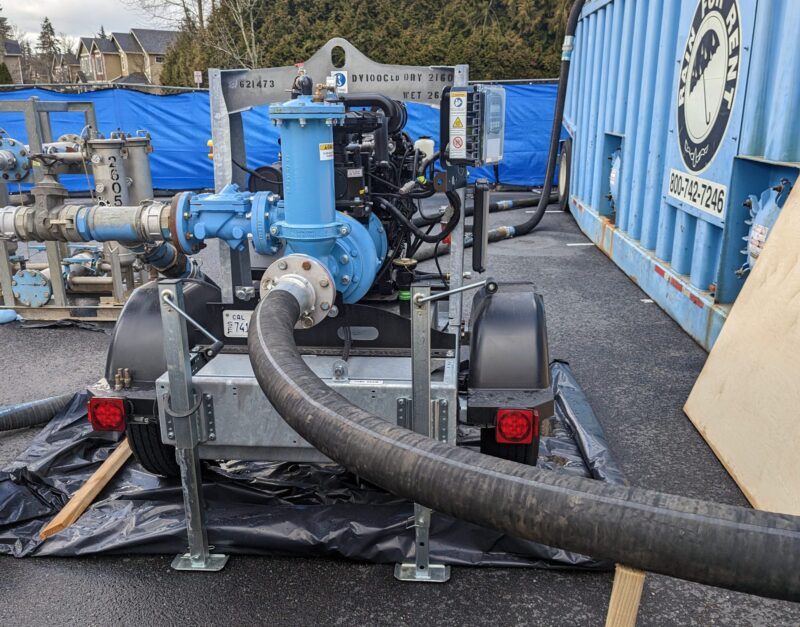

Before
Underground Stormwater Tank Dewatering
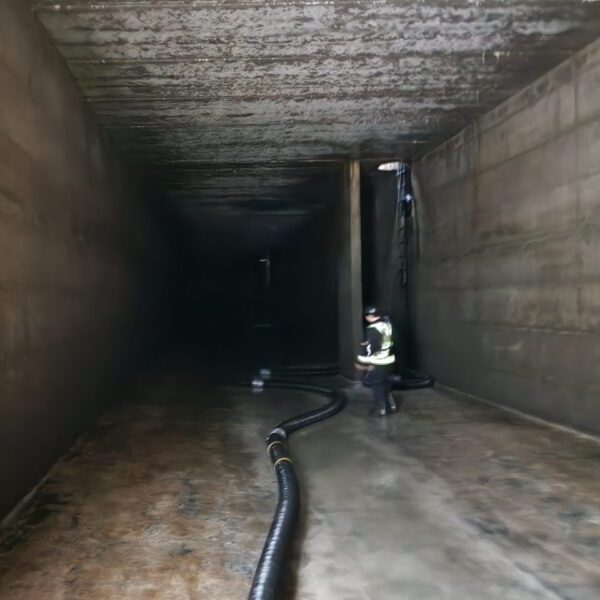
After
Underground Stormwater Tank Emptied, Cleaned and Sanitized
Solution:
Once AQUALIS became involved, the team immediately communicated to the local governing bodies the next steps to control the situation to extend the deadline of the stormwater Notice of Violation (NOV) to spare the property owners from additional fines. During the remediation, three local governments were involved in overseeing the project, because of where the stormwater drains and where the contaminated water was transported for treatment.
AQUALIS operated with the residents in mind, occupying as few parking spaces as possible, working only 12 hours a day to reduce noise disruption and installing ramps for traffic to continue to flow through the property without disturbing temporary hoses. AQUALIS notified residents of the potential disruptions related to the services and were available to answer any questions they had. The stormwater vault was located under the parking lot, so AQUALIS professionals blocked off the work area by installing safety barriers.
A stormwater diversion system had to be created to ensure full function of the property during the dewatering and subsequent phases of work. The water from the vault was vacuumed into a weir tank with the vac truck through filters and once uncontaminated, into a sewer manhole.
During dewatering, it was discovered that groundwater from an underground spring was also entering the vault via flap valves. This additional runoff added to the expected volume of the tank. AQUALIS was able to communicate the increased volume with the local governments to approve an increase of the rate of pumping and the amount of stormwater transported to King County.
The approved flow rate for dewatering allowed approximately 70,000 gallons a day to be discharged and mobilized as long as the water was maintained at the local legal water quality of total suspended solids (TSS) at 45 mg/L. Water quality is measured through testing the amount of TSS and settleable solids. The water was tested and reported multiple times a day for quality reporting and proper documentation for local government records.
As the water level inside the vault lowered, a confined space entry certified personnel entered the vault to assess progress. Through the assessment, it became clear some areas inside the vault had considerably deeper pools of water. Resulting in a necessary adjustment of the hoses inside the vault to pull as much water without solids as possible. Equipment had to be shifted around from the planned staging for the hoses to reach the excess water.
With more contaminated stormwater removed from the vault, AQUALIS professionals noted pipe openings inside of the vault that had been improperly installed. Upon approval, these were patched by AQUALIS to ensure efficiency inside the vault and avoid any future illicit connections.
AQUALIS utilized CCTV to capture footage of the stormwater discharge pipes connected to the vault and ensure no additional repairs were needed. The footage confirmed that all repairs were successful, and the illicit connections were remediated, the only remaining contamination was located inside the vault.
Once the dewatering was complete, the focus shifted to removing the remaining sediment from the bottom of the vault and cleaning. The vault, pipes and catch basins on the property, as well as affected areas downstream all had to be restored. This included six conveyance lines and five catch basins. The stormwater structures, dewatering equipment and surrounding areas were sanitized and power washed. Once all stormwater control measures were properly cleaned, the water was tested again to fulfill final completion of the project.
The location of the site provided nuanced issues as the teams continually had to battle freezing temperatures which caused pauses in each step of the process. Additionally, rainfall over the course of the project added to the volume of the stormwater vault, putting increased pressure on meeting the NOV deadline. For this property owner, working with a localized crew was a large benefit as weather delays were anticipated and communicated to the proper governing bodies and the project experienced minimal delays.
The original scope of this project changed multiple times as new obstacles emerged. AQUALIS was able to facilitate the process as smoothly as possible, alleviating stress from the property managers. Thankfully, no additional fines were implemented as AQUALIS communicated each step of the process to the local governments and properly remediated the violations in a timely manner.
Partnering with the stormwater expert, AQUALIS, will ensure your NOV will be handled in a precise and timely manner. Avoid future fines by partnering today. Property owners should implement a preventative maintenance plan to avoid costly notices of violation. During preventative maintenance visits, professionals inspect all stormwater assets for full compliance and function to ensure your next stormwater inspection will go smoothly. Schedule a free consultation now.
